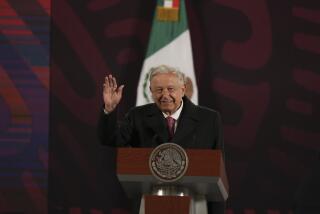Mexico Poised for Economic Vote of Confidence
MEXICO CITY — Mexico is about to offer the world a live demonstration of how important faith and confidence are to an economy.
If its national elections next Sunday are carried out “cleanly”--without tampering or egregious vote fraud--then no matter which presidential candidate comes out ahead, confidence in Mexico will surge.
Internationally and domestically, that will uncap tremendous flows of pent-up business investment and the country, without fear of inflation, will be able to push its economy for much-needed growth--4% or even 5%, sufficient to create 1 million jobs a year.
A good election will confirm the wisdom of the economic program that has guided Mexico for the last six years and from which Americans could learn a thing or two.
The latest news is encouraging. With a week to go, confidence is rising that the election will be open and above board and launch Mexico on a new political path more suited to its economic maturity.
But if the election result is clouded by substantial charges of tampering by the long-ruling Institutional Revolutionary Party (PRI), it will unleash demonstrations throughout the country. Financial markets will sell off, and investors will put their money elsewhere, deducing that Mexico isn’t going to change after all.
Why such tangible, pesos-and-centavos consequences from intangible faith and confidence?
Because of all the body blows to confidence that characterized Mexico’s economy in the 1970s and ‘80s: massive devaluations, loan defaults, nationalizations of industry. Foreign investors were burned badly, and most are on the fence today.
But that foreign discomfort was as nothing compared to the sufferings inside Mexico. In 1987, the year before the government of President Carlos Salinas de Gortari and his band of U.S.-educated “technocrats” took office, inflation in Mexico was 159% and the government deficit was 16% of gross domestic product.
Yet this year, inflation is down to 7% and there is no government deficit, zero, none.
Americans, who wring their hands over chronic government deficits, should take a look at how Mexico solved its problems. It sold state industries and used the proceeds to pay down debt. And it lowered taxes.
The result is that Mexico’s national debt today is equal to 11% of its total annual output, or GDP, compared to roughly 60% in the U.S. and more than that in Japan.
Also, lower taxes on a broader tax base have increased government revenues, while encouraging investment and saving.
“We lowered the corporate tax rate from 42% to 34% and repealed the tax on dividends,” explains Francisco Gil Diaz, deputy governor of the Bank of Mexico--the nation’s central bank--and the man responsible for the tax reform.
“For individuals the top rate was 55%. We lowered it to 35%, and we have no state and local income taxes. And we introduced a treatment for capital gains that practically means they are not taxed.
“Also if you own a share in a corporation and you are in a lower bracket than the corporate 34% rate, you can claim a credit for the difference between tax the corporation paid and the tax you owe,” says Gil, whose doctorate in economics is from the University of Chicago.
The purpose of such tax relief is that it encourages saving and capital formation in a country that is starved for capital.
Yes, but one reason for political unrest is that Mexico is a country of large income disparities, with a government that lacks credibility due to a well-earned reputation for doing favors for its friends. Was tax reform another bauble for Mexico’s billionaire families?
No, because along with lower rates went tougher collections, so that income tax revenues have risen from $5.9 billion in 1988 to $20 billion last year.
And savings among the Mexican people, even though poor, may be the surprise story of the next few years. There is pent-up demand for mortgages, which are coming back after disappearing in the inflationary chaos of 10 years ago.
There is great demand for housing, in short supply at all levels. Condominium properties in Mexico City sell for $300 to $500 a square foot, prices comparable to Beverly Hills and Manhattan’s East Side.
Change is already here in Mexico. For if tax relief was the government’s carrot for industry, the stick is competition. Trucking has been deregulated and shipping charges are way down. State-owned airlines have been sold and are now lower-priced and competitive. The privatized Telefonos de Mexico will face long-distance competition in a few years.
And Mexico is spurring bank competition by allowing new banks to form and by inviting in more than 100 foreign banks and investment firms.
Mexico’s economy remains volatile, to be sure. To finance a trade and current account deficit, the government is borrowing short term and in dollars. As Mexican industry restructures for NAFTA and global competition, earnings prospects and stock prices of Mexican companies could tumble.
But if the election goes well, the boost to Mexican business will be powerful and immediate. Specifically, Mexico will soon gain an investment grade credit rating from Moody’s and Standard & Poor’s, a measure of faith and confidence that will allow its companies to borrow at lower interest rates on world markets.
What price faith and confidence? Mexico’s companies, even big ones, are now forced to borrow at 10% to 12% interest while global competitors pay only 7% for credit.
After Aug. 21, Mexico should get to demonstrate what a renewal of confidence is worth.
* MUTUAL FUNDS: Fund managers are upbeat about Mexico. D4
More to Read
Sign up for Essential California
The most important California stories and recommendations in your inbox every morning.
You may occasionally receive promotional content from the Los Angeles Times.









